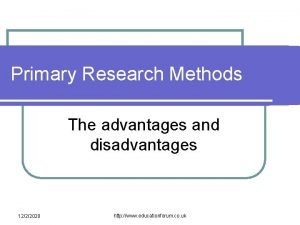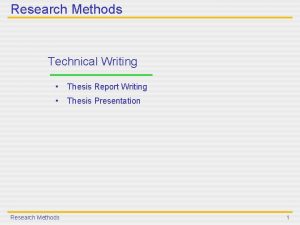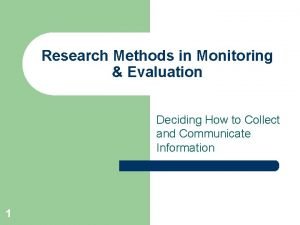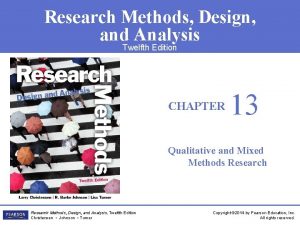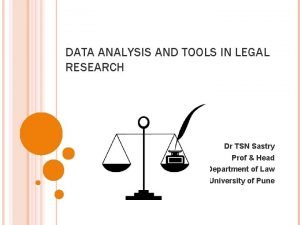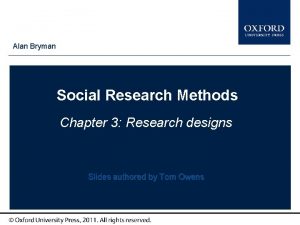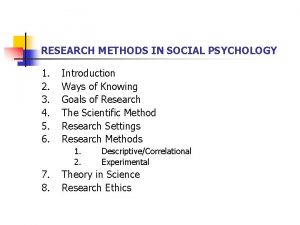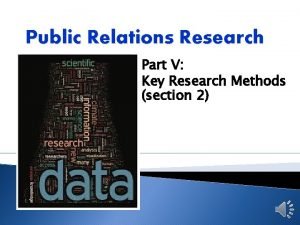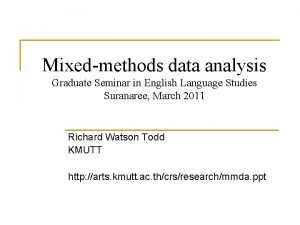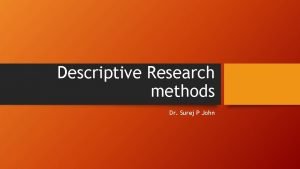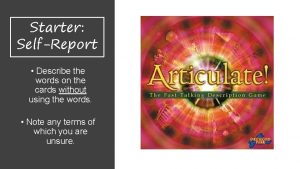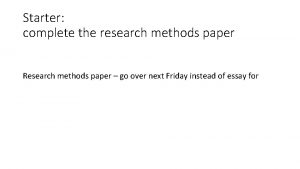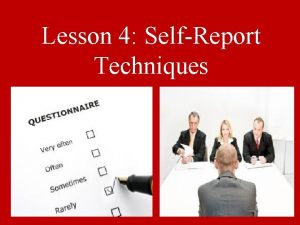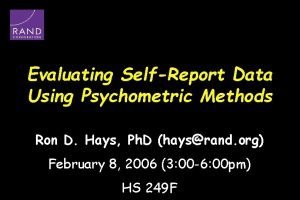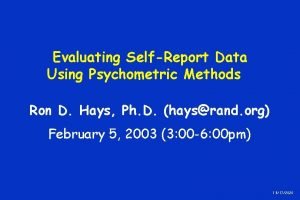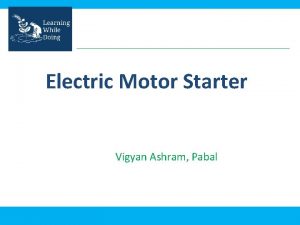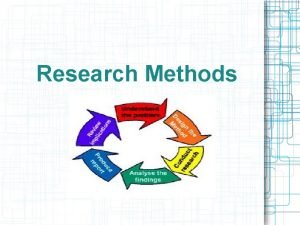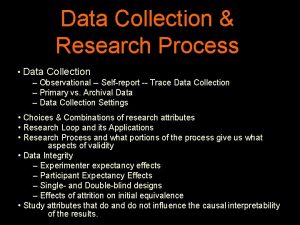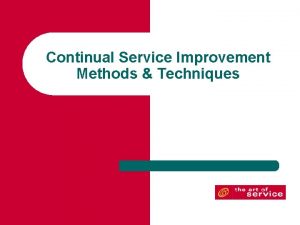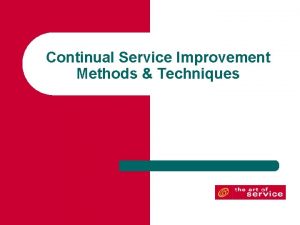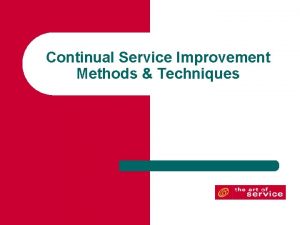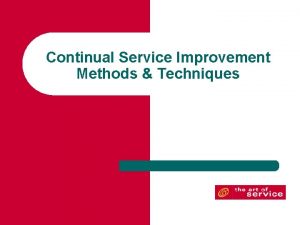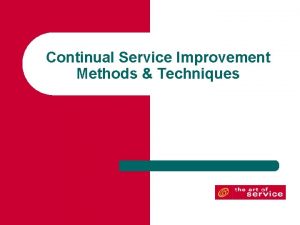1 1 Research Methods and Techniques Selfreport Starter



















- Slides: 19

1. 1 Research Methods and Techniques Self-report

Starter • Given personality questionnaire to complete • (http: //personality-testing. info/printable/big-five-personalitytest. pdf)

Self-report • Self-report is a direct way of gathering data. It involves directly asking participants their opinion. • This can be done via questionnaires or interviews. • Self-report is often the most valid way of assessing a participant’s thoughts, feelings and beliefs.

Types of self-report • Interviews – These involve direct verbal questioning by the researcher and vary in terms of how structured the questions are. • Questionnaires – These are written methods of gathering data. They do not necessarily require a researcher to be present.

Using your A 3 Capture Sheet… • What is a questionnaire • Types of questions (Incl. advantages and disadvantages) • Likert scales (incl. advantages and disadvantages) • What is an interview • Types of interviews (Incl. advantages and disadvantages)

Let’s look at some interviews and questionnaires….

Example interviews • What type of interview is this? • What’s wrong with this interview? • And sometimes this might happen…

What is wrong with these questions? 1/How many times did you shop here in 2010? 0‑ 5, 5‑ 10, 10‑ 15, 15‑ 20, 20‑ 25, 25‑ 30, 30‑ 35, 35‑ 40, 40‑ 45, 45‑ 50, 50‑ 55, 55‑ 60, 65‑ 70, 75‑ 80, 80‑ 85, 85‑ 90, 90‑ 95, 95‑ 100. 2/ What is your annual income? 3/ Do you live in Worthing? 4/ Why do you prefer out‑of‑town shopping?

What is wrong with these questions? 5/ Have you ever shop‑lifted? 6/ Do you have a busy life? YES/NO? 7/Do you think socio‑economic and political factors are militating against centralising forces in the retail‑merchandising sector? 8/ Would you describe yourself as a)upper class b)middle class or c)lower class?

What is wrong with these questions? 9/ Do you shop a) every day or b) once a week? 10/ Recent research by scientists in several universities shows that people are too busy nowadays. Do you agree? 11/ If you had a lot of shopping to do and several appointments in one evening and the car had broken down and you had just been paid, would you consider taking a taxi or a bus to an out‑of‑town shopping centre because everything is under one roof or would you feel that it would be more sensible to do your shopping in the town‑centre where you have to visit the greengrocers, bakers etc. separately? YES/NO

Choose a topic… • You will create a questionnaire based on this topic. You should include open and closed questions, alongside questions which involve Likert scales. • You will give your questionnaire to three pupils in the class • Evaluate your own questionnaire! Take note of what other people had in theirs. What could you do to improve yours?

Now… it is your turn to interview the person sitting next to you Think of a topic you wish to explore. You should have an aim in mind for what you wish to find out. As an interviewer you must select to have a: • Structured interview • Semi-structured interview • Unstructured interview Evaluate the use of the style of interview you used Compare the types of information you gathered Be prepared to share your evaluations with the class

Validity • Whether the method is measuring what it is supposed to be measuring.

Validity • Do the following improve or reduce validity? Why? • Getting people to put their names on the questionnaire. • Asking questions about sensitive subjects. • Using smokescreen questions (questions in a questionnaire that mask the • critical/important questions). • Telling participants the aim of the research. • Using open questions.

Reliability • How consistent the measure is within itself. • Can be tested using a split-half method: • Correlating the results of half the items against the other half. • If the correlation has a high and positive coefficient, then internal reliability is deemed high.

External reliability • How consistent is the measure when repeated over time? • Can be examined with the test-retest method: • Correlating the results from one time to another. • If the correlation has a high and positive coefficient, then external reliability is deemed high.

Reliability • Why do the following increase reliability? • Having a large sample. • Making sure that all participants complete the questionnaire in the same conditions. • Getting participants to complete the questionnaire twice (with a few days in between). • Making sure that all participants complete the same questionnaire.

Data • What type of data would open questions produce? • Qualitative • • What’s good and bad about this? Indepth information Small data set Specific - Cant be generalised • What type of data would closed questions produce? • Quantitative • • What’s good and bad about this? Wealth of data Generalisable Numbers, figures, no insight

• Homework: RM Workbook pages 13 -14
 Indirect methods of contoring uses how many methods
Indirect methods of contoring uses how many methods Primary research advantages
Primary research advantages Technical writing thesis
Technical writing thesis Sampling methods in qualitative and quantitative research
Sampling methods in qualitative and quantitative research Research methods in monitoring and evaluation
Research methods in monitoring and evaluation Research methods design and analysis
Research methods design and analysis Romeo and juliet starter activities
Romeo and juliet starter activities Fonction technique scooter
Fonction technique scooter Importance of data in legal research
Importance of data in legal research Alan bryman social research methods
Alan bryman social research methods Research methods notes kenyatta university
Research methods notes kenyatta university Methods of social psychology
Methods of social psychology Research methods in developmental psychology
Research methods in developmental psychology Types of time dimension in research
Types of time dimension in research Research design methods
Research design methods Pr research process
Pr research process Mixed methods research examples
Mixed methods research examples Mixed methods research examples
Mixed methods research examples Business research methods assignment
Business research methods assignment What is descriptive survey design
What is descriptive survey design

